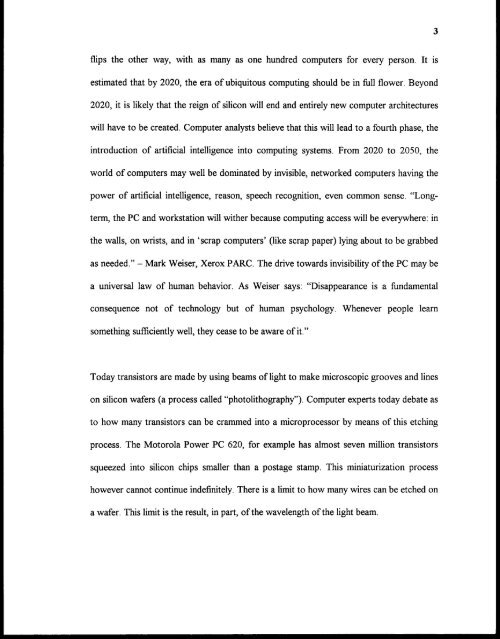njit-etd2000-029 - New Jersey Institute of Technology
njit-etd2000-029 - New Jersey Institute of Technology
njit-etd2000-029 - New Jersey Institute of Technology
Create successful ePaper yourself
Turn your PDF publications into a flip-book with our unique Google optimized e-Paper software.
3<br />
flips the other way, with as many as one hundred computers for every person. It is<br />
estimated that by 2020, the era <strong>of</strong> ubiquitous computing should be in full flower. Beyond<br />
2020, it is likely that the reign <strong>of</strong> silicon will end and entirely new computer architectures<br />
will have to be created. Computer analysts believe that this will lead to a fourth phase, the<br />
introduction <strong>of</strong> artificial intelligence into computing systems. From 2020 to 2050, the<br />
world <strong>of</strong> computers may well be dominated by invisible, networked computers having the<br />
power <strong>of</strong> artificial intelligence, reason, speech recognition, even common sense. "Longterm,<br />
the PC and workstation will wither because computing access will be everywhere: in<br />
the walls, on wrists, and in 'scrap computers' (like scrap paper) lying about to be grabbed<br />
as needed." — Mark Weiser, Xerox PARC. The drive towards invisibility <strong>of</strong> the PC may be<br />
a universal law <strong>of</strong> human behavior. As Weiser says: "Disappearance is a fundamental<br />
consequence not <strong>of</strong> technology but <strong>of</strong> human psychology. Whenever people learn<br />
something sufficiently well, they cease to be aware <strong>of</strong> it."<br />
Today transistors are made by using beams <strong>of</strong> light to make microscopic grooves and lines<br />
on silicon wafers (a process called "photolithography"). Computer experts today debate as<br />
to how many transistors can be crammed into a microprocessor by means <strong>of</strong> this etching<br />
process. The Motorola Power PC 620, for example has almost seven million transistors<br />
squeezed into silicon chips smaller than a postage stamp. This miniaturization process<br />
however cannot continue indefinitely. There is a limit to how many wires can be etched on<br />
a wafer. This limit is the result, in part, <strong>of</strong> the wavelength <strong>of</strong> the light beam.
















